| |
|

SATURDAY, AUGUST 2-SUNDAY, SEPTEMBER 7

FRIDAY, AUGUST 8


FRIDAY, SEPTEMBER 12, 2008 Temple Solel S'more Shabbat
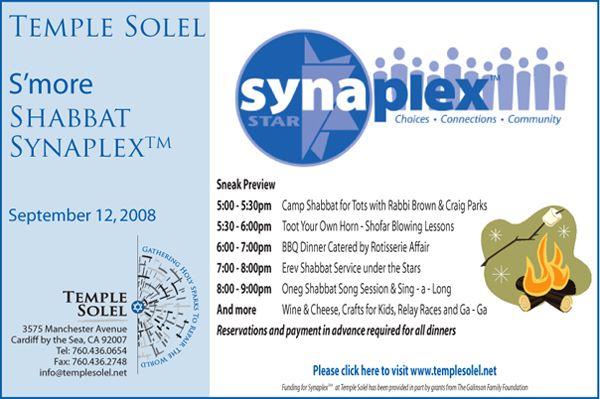
___________________________________________________________________
MON., SEPT. 29-THURS., OCT. 9


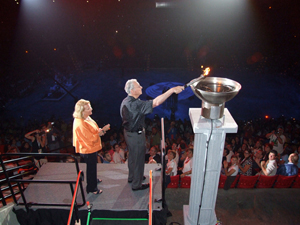 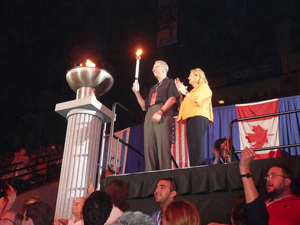
THE JEWISH CITIZEN
Let the 2008 JCC Maccabi Games begin!
Story and photos by Donald H. Harrison
Additional photos by Nancy E. Harrison and Gary Rotto
 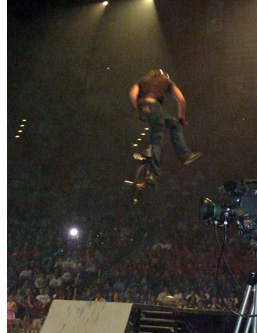 SAN DIEGO—"Reach the beach!" was the encouraging motto for teams from across the United States, Israel and Mexico to come to the 2008 San Diego Maccabi Games—first in a three-venue series of Jewish sports competitions that will be played this summer in the United States. Other competitions will follow in Detroit, Michigan, and Akron, Ohio. SAN DIEGO—"Reach the beach!" was the encouraging motto for teams from across the United States, Israel and Mexico to come to the 2008 San Diego Maccabi Games—first in a three-venue series of Jewish sports competitions that will be played this summer in the United States. Other competitions will follow in Detroit, Michigan, and Akron, Ohio.
While Cox Arena on the San Diego State College campus isn't exactly the beach, being several miles inland, the California beach style was brought to several thousand Jewish athletes between the ages of 12 and 16, their parents, coaches and numerous spectators anxious to see what was possibly the largest Jewish event held in San Diego. Beach Boys tunes—and that Beatles' classic "Octopus' Garden"—provided the surf and dance motifs for a rockin', rollickin' floor show that also featured such out-in-the-sun sports as a spontaneous hula hoop competition, and X-Treme stunts on bicycles and skate boards performed on ramps in the Cox Arena.
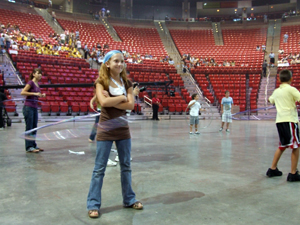 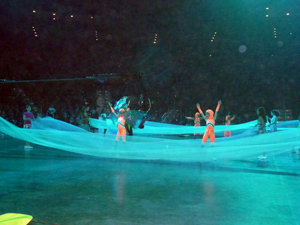
The musical star of the show, however, wasn't a Californian—but he had everyone rocking and feeling good about being a Jew: Kosher Gospel Singer Joshua Nelson, a New Jersey sensation who has married the Black gospel sound to the Jewish musical canon. He had the crowd up on its feet for H'nai Matov, and seemingly when he was concluding the set, he asked: "Would you like to hear it the way we sing it in our synagogue?" "Yes," the crowd roared back, and as good as the previous version might have been, this one had 'em dancing in front of their arena seats.
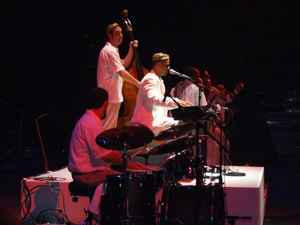 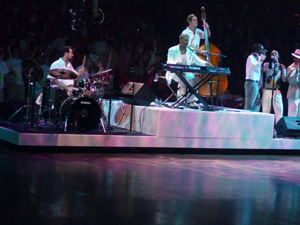
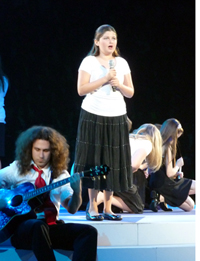 The JCC Maccabi Games started 25 years ago, the year following the slaying of 11 Israeli athletes at the 1972 Munich Olympic Games by Palestinian terrorists who called themselves the "Black September Movement." After a touching video tribute to the martyred athletes, the crowd was led by Celia Tedde (at left) of the J*Company in a moving rendition of "Shalom Rav." Like a Jewish wedding when we break a glass to remember the destruction of the Temple, so too did Sunday night's kickoff for the JCC games mix the happy and the sad--a reflection, one might say, of life itself. The JCC Maccabi Games started 25 years ago, the year following the slaying of 11 Israeli athletes at the 1972 Munich Olympic Games by Palestinian terrorists who called themselves the "Black September Movement." After a touching video tribute to the martyred athletes, the crowd was led by Celia Tedde (at left) of the J*Company in a moving rendition of "Shalom Rav." Like a Jewish wedding when we break a glass to remember the destruction of the Temple, so too did Sunday night's kickoff for the JCC games mix the happy and the sad--a reflection, one might say, of life itself.
Numerous celebrities from the JCC Movement were introduced, along with recently re-elected San Diego Mayor Jerry Sanders and his wife, Rana Sampson, often described by San Diego Jews as "our Jewish first lady." The couple welcomed all the athletes to San Diego, and in best political tradition, wished all of them the best of luck. The games will officially begin on Monday with the championship rounds to be held on Thursday.
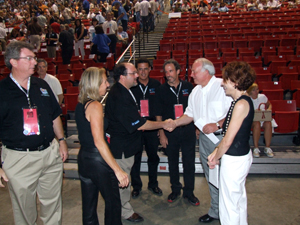 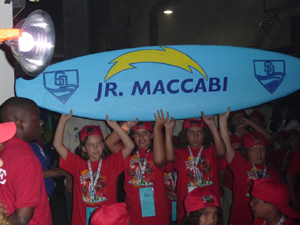
For many, the most exciting parts of the ceremonies were the beginning and the ending. The athletes had been milling for more than an hour in a courtyard of Cox Arena, waiting to make their entrances, and when their team's names were announced, it was hard to hold back the enthusiasm. The first to enter the arena were members of the Junior Maccabi Squad, who are too young to compete in the games this year but proved to be some of the most intense fans.
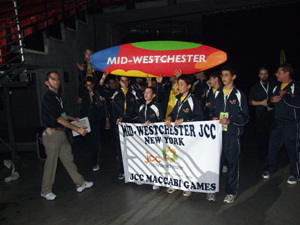 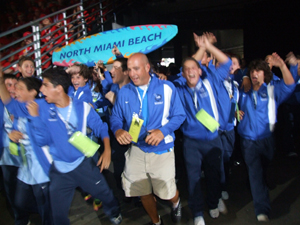
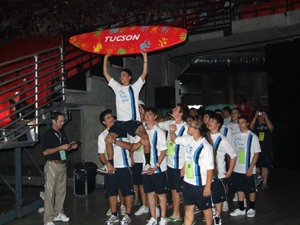 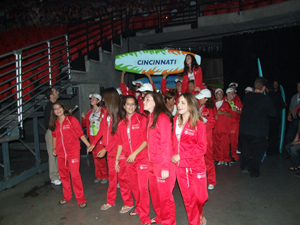
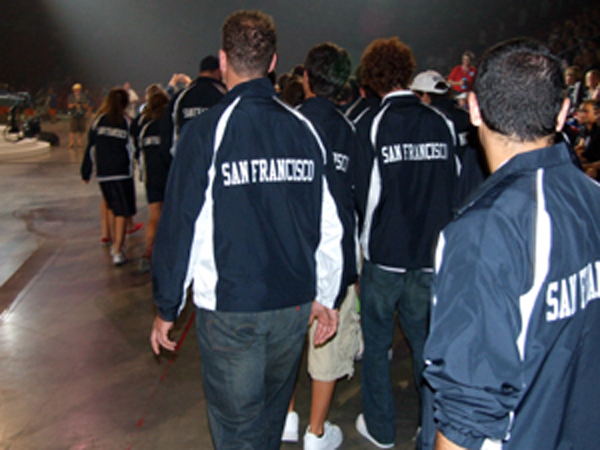
They were followed by teams from all parts of the United States—northeast, southeast, southwest and inland—all building up to Team Mexico, some of whose members wore sombreros; Team Israel, some of whom will compete as part of the San Diego team in honor of the special partnership relationship between San Diego and the Sha'ar Hanegev region of Israel near the Gaza border; and of course, the host Team San Diego, whose entry in wave after wave of enthusiastic athlete produced a roar from the clearly hometown crowd.
An anomoly of the ceremony was that the National Anthems of the United States, Canada, and Israel, which are officially partners in staging the JCC Maccabi Games, were performed during the evening. But there was no delegation of athletes from Canada—their teams possibly having opted to compete in the upcoming games in Detroit or Akron. Meanwhile, the National Anthem of Mexico--which was represented by a large and enthusiastic delegation—was not played, making some in the audience fear that the delegation had been inadvertently snubbed. In fact, proper protocol had been followed, but some felt a special recognition for the Mexicans would have been a nice gesture.
The closing part of the ceremony (pictured at the top of this article) involved various ranking officials of the local JCC movement carrying a torch, from the wings to center stage, from center stage up a flight of steps (David Wax, JCC president, and Mike Cohen, JCC executive director) , and finally to a platform where Qualcomm co-founder Irwin Jacobs and his wife, Joan, were waiting. The Lawrence Family JCC officially is lodged on the "Jacobs Family Campus," a recognition for that family's well-known philanthropy not only for Jewish causes but also for education and the arts.
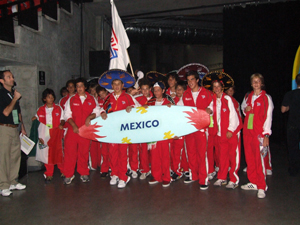 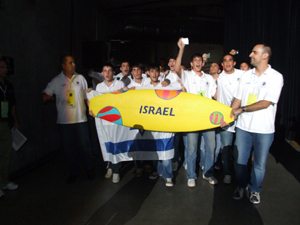
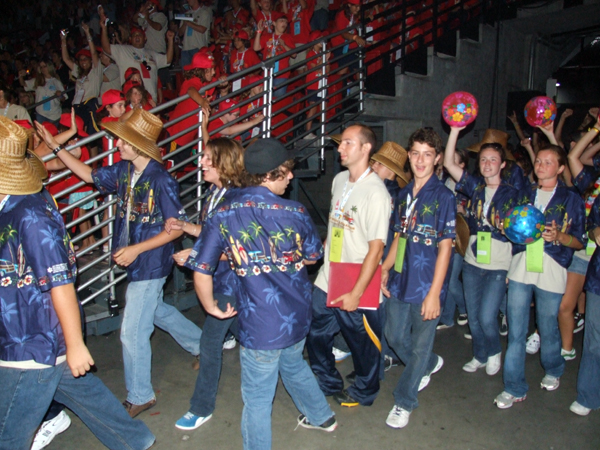


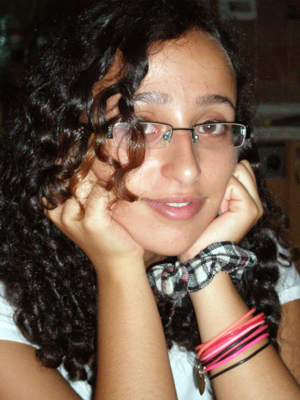 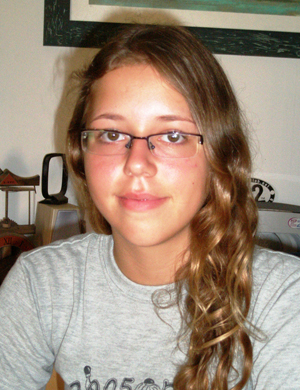
FROM THE GATES OF THE NEGEV
Kibbutz kids experience life 'on our own'
By Ulla Hadar
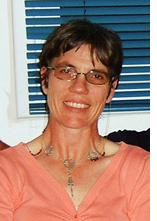 KIBBUTZ RUHAMA, Israel—Two 13-year-old girls from this kibbutz on the eastern side of the Sha'ar Hanegev municipality, Daria Presenko and Daniel Kliger, were among 40 teenagers who attended a two-week summer camp in an area of Israel far from the Hamas rockets that are fired over the Gaza border except in times like now of shaky ceasefires. KIBBUTZ RUHAMA, Israel—Two 13-year-old girls from this kibbutz on the eastern side of the Sha'ar Hanegev municipality, Daria Presenko and Daniel Kliger, were among 40 teenagers who attended a two-week summer camp in an area of Israel far from the Hamas rockets that are fired over the Gaza border except in times like now of shaky ceasefires.
All 40 campers chosen from Southern Israel live within range of the rockets, and, according to AJC's National Director, David Harris, "We could not think of a more meaningful way to touch the lives of these children, especially with the trauma they've experienced from rocket and mortar attacks from Gaza."
Although the camp was subsidized with contributions from the Israel Emergency Assistance Fund of the American Jewish Committee, the "E" in "E-Camp" is not for "Emergency;" it is for "electronic" as in "E-mail."
The campers went for two week to Aloney Yitzhak, a residential educational facility near Caesarea, where they stayed three to four campers to an air conditioned room. They participated not only in computer-type programming but also in such usual, and welcome, camping fare as swimming, basketball, soccer, martial arts, trips, campfires, picnics, a talent show, and an end-of-camp party.
"When we arrived at the camp, the counellors took all the cell phones from us, which was a great shock" said Daniel, whose name in Hebrew is spelled the same for both girls and boys. "Israeli children without a cell phone is something not normal."
"It was a little bit strange to be far away from home on my own without my parents," she added. "We were only allowed to talk once a day with our parents using the Skype program on the computer. For me, it was a different experience—a way of disconnecting from everything, of living in another way, different from anything I have felt before."
Daria said she was kept so busy at the camp she didn't have time to miss her home and family.
"The camp is a technology camp and we had all kinds of lectures telling about new inventions, all kinds of computers and software programs, Playstations, etcetera. Cool stuff! Everyday we participated in three different workshops."
The two young kibbutzniks shared workshops in digital music and Photoshop. But they went separate ways for a third workshop, with Daniel choosing comics and Daria videoclips.
"What we were taught in the workshops is something I can use in the future," said Daria.
Although there were some students attending the camp sessions from outside of Israel, Daniel said in her age cohort there were not many children from abroad "For me, it was more natural to connect to the ones my own age," she said. "We had to go through all the new different experiences together and the fact that at the same time all of us were away from home and our families really tied us close together."
She added: "I think was the most important experience for me. Now I fell more mature and grown-up, knowing that I can be away on my own and handle situations like this one."
In contrast, Daria said that "meeting with teenagers from abroad was the strongest and most positive experience I received at the camp. I made very good contact with a girl from California and we are going to be in touch in the future."
She commented that "neither of us would have been able to go to a camp like this if we had not been granted the scholarships and we will definitely recommend to others to attend if possible." Both girls, during the interview, expressed their appreciation to the American Jewish Committee.








Did Hitler's Jewish mentalist prophesize that someday Nazis would murder him?
Mind Reading and Telepathy by Eric Jan Hanussen, published in English by Jimmy Bix, Vienna
By Joel A. Moskowitz M.D
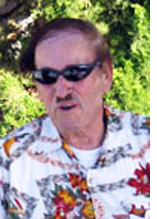 LA JOLLA, California—If Eric Hanussen were still alive, he might well have predicted that I would write about him almost exactly six years after reviewing in the September 2002 Linking Ring, a book by Mel Gordan on his life. LA JOLLA, California—If Eric Hanussen were still alive, he might well have predicted that I would write about him almost exactly six years after reviewing in the September 2002 Linking Ring, a book by Mel Gordan on his life.
That review, “Eric Jan Hanussen-Hitler’s Jewish Clairvoyant," won the esteemed Best Article that year which included the Howard Bamman Trophy.
Mind Reading and Telepathy, actually written by Hanussen, the mysterious mentalist, was originally published by Waldheim-Eberle Verlag A.G. in Vienna in 1920. It was discovered and translated into English by Jimmy Bix in 2007.
Hanussen’s relatively short life (born 1889 – murdered by the nazi SS in 1933) was paradoxical, astounding and fraudulent. Jewish and the son of a synagogue caretaker, he is said to have met Hitler and coached him in subtle methods whereby he might influence crowds with his gestures. As such, although a Jew, he was considered an honorary Aryan. It is believed that Hitler’s meteoric and violent rise to power hinged on the burning of the Reichstag, Germany’s parliament. Hanussen predicted that this seat of government would burn. Some think that he actually hypnotized a confederate to do the deed and later ‘found” i.e. ratted him out. Hanussen enjoyed fame as a stage mentalist and through his alleged associations with Hitler was referred to as “Hitler’s Nostradamus” and the prophet of the Third Reich because of the seeming accuracy of his predictions. Those who admired him less called him the Devil’s prophet.
Hanussen’s Curriculum vitae included his having left school at an early age to join the circus, having been a knife thrower, fire-eater and professional strong man. While serving in World War I he impressed his officers by an ability of water witchery without dousing ‘tools’. He became part of the troops' entertainment. His ultimate fame and likely his downfall, however, mostly depended upon his ability to predict the future.
One might have thought he would have ‘anticipated’ his bad end. Some papers suggest he had a hunch that the Nazis weren’t entirely happy with his “knowing."
As a member of Psychic Entertainers of America, I recall debates as to whether mentalists should make it clear that they had no special powers. Charged with bilking ‘gullibles’ by professing to foretell financial futures, he was hauled before a Czech court. His defense hinged on a series of amazements: he told the prosecutor that which was in his very pockets; the trial judge was surprised that Hanussen could know the contents of his briefcase; and, the capper was that Hanussen announced if the police would hurry they could apprehend a bank thief as he was standing on the station waiting for a train that very minute! Hanussen, having proven his extraordinary powers, was acquitted.
Meteoric stage success enabled him to purchase and publish an occult themed journal, which included a popular astrological horoscope section. The prophet’s profits made it possible for him to buy a mansion, which he named The Palace of the Occult. There he performed séances. Not ashamed to employ pre-show ferrets to gather useful information and trickery, he was credited with also being an extraordinary Menchen Kenner (knower of people). His sensitivity to the soft behaviors (unconscious physical movements of people) allowed him, combined with Cold Reading, to divine their inner thoughts.
This volume is a description of his techniques.
As interesting and valuable are his methods, which are detailed, are the commentary introductions. Banachek, himself an accomplished seer, marvels that Hanussen had the courage to wager his freedom in the Czech trial on trickery. Proficiency in muscle reading, also referred to as Hellstomism of Psychophysiological Thought Reading, involves elements described by Hanussen. Banachek asserts that this book written six decades past has present value.
Professor Dr. Toni Fisher elaborates upon the continued fascination with Herschmann Chain Steinschneider, aka Eric Jan Hanussen, which includes several books, films. He writes that Hanussen was Chutzpadik, i.e. had lots of nerve. For example, he practiced hypnosis with not a great deal of study of the art. Seemingly Hanussen wrote the book Mind Reading and Telepathy when he was not performing mentalism. When that became the cardinal feature of his stage act, he sought to have the book withdrawn lest his secrets become public.
The author’s collection of predictions did not include that one-day the magic/mentalism fraternity would discover his book. As noted, he may not have been sharp enough to predict that he would be murdered. Another mentalist, Alexander, has a slogan “He Who Knows All”; the Nazis decided that Hanussen knew too much! Furthermore, he had lent some of the Nazi leaders great sums of money. By his demise, their debts went away as well. Jimmy Bix provides photos of the suspected murderers: Karl Ernst, Rudolph Steinle, Kurt Egger, and Wilhem Ohst. These uniformed Nazis, it is suggested, were instrumental in bringing down the curtain on Eric Jan Hanussen.
This reviewer predicts that diligent students of mental wizardry who devote the time to study Hanussen’s re-published book will have an excellent course in analyzing our tell tale twitches and thereby be on the road to mentalist's stardom. And finally, a post-hypnotic suggestion: “Upon completion of reading this essay, you will have an irresistible urge to contact Murphy’s Magic Supplies, www.murphysmagic.com, to purchase your copy of this fine book.


REFLECTIONS
Gelsey Kirkland, prima ballerina, teaches special session at City Ballet of San Diego
By Sheila Orysiek
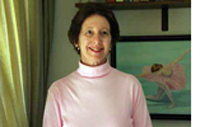  SAN DIEGO—Steven Wistrich, artistic director, and Elizabeth Wistrich, resident choreographer, of City Ballet of San Diego know the importance of bringing in extraordinary teaching talent from the upper firmaments of ballet heaven. These teachers offer a fresh viewpoint and other ways to approach dance. SAN DIEGO—Steven Wistrich, artistic director, and Elizabeth Wistrich, resident choreographer, of City Ballet of San Diego know the importance of bringing in extraordinary teaching talent from the upper firmaments of ballet heaven. These teachers offer a fresh viewpoint and other ways to approach dance.
Outstanding ballerinas and danseurs can generally be divided into broad categories such as “bravura,” “dramatic,” “heroic/heroine,” “virtuoso,” or “lyrical.” While most great dancers are accomplished in more than one sphere - each tends to excel in a particular style. But one ballerina in particular doesn’t quite fit snugly into a category and thus one hears when her name is mentioned: “and then there is Gelsey Kirkland.”
Kirkland, shown in the above right portrait by Dina Makarova, transcended all of these categories - on a misty mountain by herself - taking us to her own special magical place. But if one had to pick a category in which she excelled - she was a lyrical ballerina in every sense of the word - a poem of dance.
A prima ballerina is a rare jewel, a lyrical prima ballerina the rarest of the jewels. Kirkland was such a rarity. Many who read this will have seen her as she starred in the Nutcracker with Mikhail Baryshnikov which has been shown on television since 1978. As a principal dancer with New York City Ballet, American Ballet Theatre and as a guest principal dancer with The Royal Ballet, Covent Garden, London, she inspired choreographers George Balanchine, Jerome Robbins, Anthony Tudor and John Neumeier to create major ballets for her. Balanchine described her as a hummingbird.
Illness, injury and personal challenges interrupted and shortened her performing career. However, she has since taught, coached and set ballets such as the major production of Sleeping Beauty for American Ballet Theatre in which she undertook the character role of Carabosse - the wicked fairy.
In the 1980’s I attended a performance of La Sylphide in which Kirkland was partnered with the late Patrick Bissell. It was an evening that lives indelibly in my mind. As the Sylph steps through a tall paned window, pauses on the sill, one foot crossed in front of the other, her hands delicately framing her face - it was the kind of magic moment for which one attends the theater; the mystery of a ballerina as she graces and takes possession of the stage. One is reminded why the royalties of France, Denmark and Russia fell in love with the ballet.
On July 30, 2008, I was invited to observe a class taught by the ballerina who was that Sylph - who is still a vision in my mind. She permits no interviews, but simply watching her teach was a treat.
The Setting
City Ballet’s studios are entered through - literally - a hole in a wall in an alley - up a flight of enclosed stairs with the prospect of what awaits at the top invisible. A warren of offices, lobby and studios all overrun with young people in various stages of ballet attire; lots of bustle and anticipation.
Approximately 30 dancers, intermediate and up, crowded into a studio already sultry. The number of observers was strictly limited - approximately ten - with chairs ranged around a front corner of the room. Upon taking a seat, one adheres to an unspoken protocol - silence throughout the duration of the class and no moving about to distract teacher or students in any way. The class was two hours in length.
Steven Wistrich graciously introduced Kirkland, welcoming her back and complimenting her on the positive effect of her teaching in previous engagements with City Ballet. The ballerina is a petite lady with a strong voice that easily cuts through the piano as well as the sound of jumping bodies responding to gravity. Attired in clunky black shoes - much like heavy duty walking shoes - loose black trousers, a black shirt with a loose white shirt on top, one would think that she was too covered up to see the beautiful ballerina beneath. But - it would be wrong to come to that conclusion.
This sublime dancer could not be hidden by her everyday clothing. I could easily discern the regal ballerina in a white tutu dancing Balanchine’s Theme and Variations with Baryshnikov to Tchaikovsky’s sweeping music. The Sylph of La Sylphide was there, too. The way she stood, the direction of her eyes when she moved, the grace of her arms, the flow of that grace into her fingers - had she been fully veiled - that grace would have shown through. Nothing could hide it.
Performing is about preparing oneself to communicate with an anonymous audience. Teaching is about - all about - communicating one on one, even in a classroom setting; from teacher to student. For a prima ballerina to make the transition from one state to the other is to turn herself inside out and find within a new persona, a new vehicle through which to communicate. For the student - no matter the level of accomplishment - being under the eye of a legendary ballerina is daunting. One is constantly tempted to simply stop and watch because when such a dancer teaches - it’s a ballet.
Kirkland presents the most lyrical ballet class I’ve seen in a long time. She continuously emphasized the coordination - she called it “organization” -between the hands, fingers, direction of gaze and inclination of head. Most ballet classes - and therefore students - are very much caught up with degree of turnout, leg extension, height of jump, - and while to an extent this is necessary - it is not the final goal. To Kirkland it isn’t dance until the eyes, arms, fingers - dance. She puts the beauty back into the art form - gives it the importance it originally had. Though her own dancing was technically as perfect as one could get - she obviously considered that secondary to the element of living beauty which is the imprimatur of a true classical lyrical ballerina.
She said:
“Create a world for people in the audience.”
“Plan ahead to look where you want the audience to see.”
“Eyes and fingers open at the same time. Open out the space around you.”
“Look like you are looking at something amazing and everyone will want to know what it is.
“See a light at the end of a tunnel.”
“Your fingers are like your eyes, they have to “see” too.”
“The hand-eye relationship is like a beautiful mystery.”
“Your spirit has to come through your arms.”
“Draw the line with your fingers.”
She did not neglect technique, but placed it within the context of supporting the presentation. “Line of sight” was dissected into various diagonals (left/right, lowered, erect, lifted), but as important was that the eyes be open - seeing - truly seeing - and therefore engaging the audience.
When she demonstrated - no matter the tempo - she presented a complete picture - her eyes open - her spirit coming through her arms, her fingers drawing the line. For those students able to incorporate her ideas, the result was striking. Suddenly, they weren’t simply dancing - they were alive and dancing.
I would very much have liked to approach Kirkland at the end of class to thank her for the many joys her dancing gave me - and the imperishable memory of a sylph stepping through a window, pausing for a moment - which for me has lasted a lifetime. But I dared not. Instead I left a card for her with a painting I did of Prima Ballerina Assoluta Mathilde Kchessinskaya - and a word of thanks for the joy her dancing brought to me.
The Class
Before the first plié, Kirkland set the opening of the arm, adding a lyrical element to the usual bras bas to devant to a la seconde (arms moving from low in front, to front, and to the side). It was only when this was achieved did she go on to set the plié exercise.
In tendu (stretching of the foot), she stressed separating the parts of the foot as it stretches out and then returns; “Massage the floor. When you extend into tendu, be a lion with a big claw.” The reach of the arm from the rounded devant (front) to allongé (stretching out of the arm) is not so much a straightening of the arm, as “stretching out of the fingers.”
The second tendu exercise included instruction for “diagonal line of sight” for eyes and inclinations of the head: right/left, up/down, front, effacé/ecarté, (open/diagonal) with corresponding arms. Thus she added to the Cecchetti School head positions (lifted, erect, lowered, turned and inclined) to include three different levels for each inclination.”
She wanted balance tested by letting go of the barre in the degagé/battement glissé (small disengagement of the foot from the floor), pas de cheval (step of the horse), but her continuing emphasis throughout was “line of sight.” Some students began immediately incorporating this important element, but others remained glued to their image in the mirror. One shouldn’t therefore assume the instruction was lost; it may simply take time for the student’s understanding and ability to incorporate it. In the rond de jambe a terre and en l’air (circle of the foot on the ground and in the air) she wanted balance checked as each rond (circle) was completed - a splendid idea.
None of the exercises - either barre or center - were complex in composition, the complexity and the challenge was her insistence on a total picture; planning ahead the choreography for the head, arms, fingers and eyes. She also varied the tempo at which this all occurred; sometimes the arms flowing from position to position, and sometimes arriving as an explosive finish.
She discussed the “primary focus” when in balance, the body being “organized” with a slight opening of the ribs while the navel is pressed against the spine.
In fondu (supporting knee is bent), the timing of the working and supporting leg - opening and closing together was demonstrated; an often overlooked component in this particular exercise. In fact, it is this element which makes the exercise valuable. In addition, as with everything - everything - Kirkland, wanted all the port de bras (movement of the arms), head inclinations and corresponding line of sight - planned out and shown.
She also spoke about “having somewhere to go.” If the head is constantly lifted - it can’t go up higher. However, if it starts down it can move through many degrees before reaching its final height. This is true of arms, which she demonstrated in port de corps (forward/back movement of the body) - going front, recovering to vertical, and then instead of going straight into the backbend, moving forward a little and then back. This adds a lyrical movement and becomes a dance rather than a back stretch at the barre.
The adagio was a study in effacés (open positions) and ecartés (diagonal positions), which opened new possibilities for the arm/head/eyes/fingers choreography. She constantly reminded the dancers to plan ahead - pick their focal points, but wanted this done with subtlety.
Her flow of energy instruction continued into the leg stretch - heel in hand - segment saying: “Drive the energy down through the supporting leg.”
Kirkland corrects the class fairly extensively between right/left execution of the exercise. Though corrections are given to the group, rather than individually, she praises both group and individually. The class is a positive one; I didn’t hear any negative admonitions.
The center began with a lyrical adagio and the visual instruction: “As you extend the leg, scoop out the energy.” Added to previous comments concerning “line of sight” was: “When you move the focus moves.” Adagio was followed with a tendu. Many teachers use this order of progression in the center, but it is not one I understand. Seems to me that just as at the barre, the sequence should be tendu first and then adagio.
She suggested using a stretched rather than a curved arm in front as preparation for pirouette. Baryshnikov, she told the class, turned with his arms en bas (low in front), using only his chest for power. The pirouette exercise she set combined en dedans (inward turn) and en dehors (outward turn), ending in fifth position (a more difficult way to finish) rather than fourth. She wanted the hands to continue the movement after the pirouette - finishing the picture after the legs had come home. She described: “One arm opens the door to the pirouette; the other arm closes the door.”
Center continued with a gallop, en diagonal, of chassé coupe (chased/cut step); a quick tempo of petit jeté (small throw/kick of the leg), and chassé (chased) turns, and then a study in sissonnes. (Sissonne is the name of the originator of the step - but some believe it is “scissors step.”)
As Kirkland demonstrated each sequence, albeit not fully executed in the legs, it was entirely fully realized in the presentation of her head/arms/eyes/fingers; like a Mozart symphony, fully realized at birth - complete. Class continued with a grand allegro (big quick steps) including grand jeté (split jump), temps de fleche (step of the arrow) and grand assemblé (big assembly of the legs in the air). In the temps de fleche, she drew attention to the slight backward inclination of the upper torso.
Class finished with a port a corps front/back and a reverence (curtsey/bow) followed by well deserved applause from students and observers.
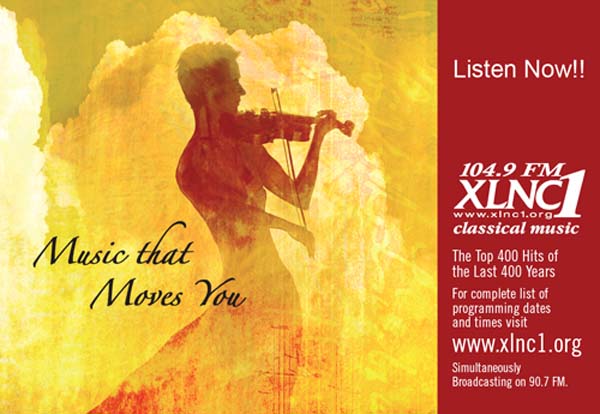

ADVENTURES IN SAN DIEGO JEWISH HISTORY
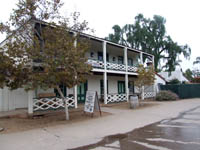
Robinson-Rose House
|
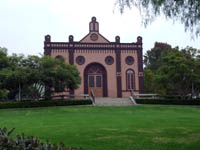
Old Temple Beth Israel |
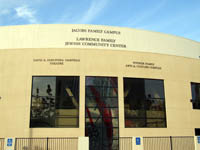
Lawrence Family JCC |
Editor's Note: To create a permanent and accessible archive, we are reprinting news articles that appeared in back issues of various San Diego Jewish newspapers. You may access an index of the headlines of those articles by clicking here. You may also use the Google search program on our home page or on the headline index page to search for keywords or names.
New Year’s Message to Members of Tifereth Israel Synagogue
From Southwestern Jewish Press, October 1949, page 1
By Isadore Jacobson
President, Tifereth Israel Synagogue
Before we close our personal life record book for the past year and commence a new one, we look back to recount the good and noble deeds we have accomplished during the past out going year towards our fellow man and our Synagogue.
We ask ourselves, “have I done my part well in the sincere interest of our beloved synagogue; have I attended services, carried out the duties assigned to me; have I met my pledges and worked faithfully and diligently towards the future welfare of our sacred traditions?” If you feel that you have done these satisfactorily in your own mind, then your closing balance in your record book should be one of joy and happiness, and you can feel responsible for adding another link in the Golden Chain of Judaism.
Commencing the second year in our New Synagogue we all feel that since its establishment, the Conservative Jewish Movement has met with success. Through the fine efforts of our Worthy Rabbi Monroe Levens, our membership has grown, our Sunday School now has ten teachers, our youth organizations are showing a great deal of Jewish interest and the Friday night services are well attended.
We are looking forward to the building of our Social Center in the near future.
Now I personally wish to thank our Rabbi, all of my faithful officers and trustees, the entire membership of our Congregation, the Daughters of Israel, the Sisterhood, the Tifereth Israel Men’s Club and all of the Jewry in San Diego who worked so sincerely towards this most successful goal.
May the Almighty God record each and every one of you for a Healthy, Happy and Prosperous New Year, so that you may continue in the cause of Judaism, Israel and Our Faith.
“Hear the Sound of the Shofar for L’Shono tov Tikoseva.”
Father and Sons Nite Planned for Temple Men’s Club Oct. 18th
From Southwestern Jewish Press, October 1949, page 4
Plans are rapidly nearing completion for the First Annual Father and Sons Meeting of the Men’s Club of Temple Beth Israel.
The Program Committee of the Temple Men’s Club has gone all out in preparation of something that is really Super-Special, and in line with the expanded activities of the Men’s Club.
Among other entertainment features, there will be presented—for the first time at Temple Center—six outstanding boxing matches embracing all of the fighting weights from paperweight to heavyweight.
The fighters are all from the Armed Forces—except the paperweights, who will be lent by their respective for brief ring appearances.
A full sized professional fighters ring will be set-up in Temple Center and all the trimmings that go with an all-masculine affair will be presented as event No. 1 on the lengthy list of activities programmed for the coming year by the Men’s Club.
An outstanding name among magicians will also put in an appearance to add to the general fun for the youngsters—in the brief intermission during which time the Men’s Club will hold a short meeting.
Serving booths will be set up at various spots along the walls at Temple Center, whre refreshments will be served. Admission to the entire affair is free! You merely pay the actual cost of bringing the food to you, if you want to.
The Boy Scout Troop, made up of handicapped boys, a prime activity of the Men’s Club, will also be in attendance at the Father and Son Meeting, as will a group of men from the naval Hospital—all of whom are to be the guests of the Men’s Club.
That date, Father and Son—is Tuesday October 18th. Cone on over, even if you have to bring somebody else’s son.
Zionists Sponsor Israeli Lecturer Thursday, Oct. 28
From Southwestern Jewish Press, October 1949, page 1.
On Thursday, October 27th at 8:15 p.m., the San Diego branch of the Zionist Organization of America will present an outstanding young Israeli lecturer to the Jewish Community of San Diego.
Alisa Klausner Eskol, a native born Palestinian who from earliest childhood witnessed and participated in her country’s development from a barren desert to full-fledged nationhood, will address the Zionist members and all guests that evening in Tifereth Israel Synagogue, 30th and Howard Streets.
Dr. Walter Ornstein, president of the Z.O.A. in San Diego, cordially invites everyone to attend this meeting, Thursday evening, October 27th to hear this dynamic, radiant personality who often has been called “Israel’s most captivating good-will ambassador.”
Mr. Raymond Bass, program chairman for Z.O.A., announces that there will not be any solicitations that evening.
San Diego Lasker Lodge B’nai B’rith
From Southwestern Jewish Press, October 1949, page 4
Final plans for the 86th Annual Men’s Convention of B’nai B’rith Gran Lodge District No. 4 scheduled to take place at Las Vegas, Nevada, from October 23 to 27, were discussed at a recent conference at Las Vegas.
The Convention, which will feature addresses by Richard Gutstadt, National Chairman of A.D.L. and Maurice Bisgyer, Secretary of the Supreme Lodge, also promises to be memorable for th program of “western hospitality” mapped out by the host Lodge.
More than 2000 persons from eight Western States an British Columbia are expected to congregate in Las Vegas.
San Diego Lasker Lodge delegates are President William Schwartz, Edward A. Breitbard, Zel Greenberg, Jerry Freedman, Harry Mallen, Morrie Kraus and Jack Dembo.
These San Diego men will attempt to bring the next B’na B’rith Convention to San Diego in 1950. Basic plans are made, and the delegation has the promise of the San Diego Chamber of Commerce’s assistance for this major project.

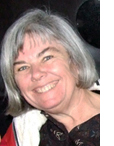 Nancy Harrison Nancy Harrison
cruise & tour specialist
(619) 265-0808

SAN DIEGO JEWISH WORLD THE WEEK IN REVIEW
InternationalBush hopes to salvage Mideast success unrealistic with decline in Olmert's power by Ira Sharkansky in Jerusalem
Decisions continue with or without Olmert by Shoshana Bryen in Washington, D.C.
Judaism
Leaving matters on a positive note by Rabbi Leonard Rosenthal in San Diego
Sports
JCC Maccabi Games: Co-ed flag footballers are "two-a-dayers" by Gary Rotto in San Diego
A bissel sports trivia with Bruce Lowitt in Clearwater, Florida
Arts
Lombrozo's 'Air Filter' reflects skyline, role of 'urban tree' as waterfront show launched by Donald H. Harrison in San Diego
Adventures in San Diego Jewish History
—October 1949: Kaufman Appointed New Managing Editor Of The Jewish Press
—October 1949: Notice {Publication Date Change}
—October 1949:New Federation Plans Survey
—October 1949: Editorial Page… Policy
—October 1949: Overseas News and Views by Maxwell Kaufman
Environment
Abramson is helping to preserve the earth one diatom and polar bear at a time by Donald H. Harrison in San Diego
Arts
Yank! A New Musical explores the travails of gays in the military during WWII by Carol Davis in San Diego
Assassins:Creepy subject, yet good musical by Cynthia Citron in Hollywood
Chapter 19 of Reluctant Martyr, a serialized novel by Sheila Orysiek
Sports
Backroom hums as Maccabi Games near by Gary Rotto in La Jolla, California
Adventures in San Diego Jewish History
—September 1949: San Diego Lasker Lodge B’nai B’rith News by Morrie Kraus
—September 1949: Samuel I. Fox Lodge No. 1747, B’nai B’rith
—September 1949: Kaufmans Return From Two Year European JDC Work
—September 1949: Esther Weitzman Given Signal Honor
International
Peace negotiations produce little news by Ira Sharkansky in Jerusalem
Temple Solel travelers inspect soldiers' quarters as part of 'Project Kibbutz' by Ulla Hadar in Kibbutz Ruhama, Israel
National
How kosher was the U-T's meat coverage? by Gary Rotto in San Diego
Arts
Thursdays with The Songs of Hal Wingard
—#37, Growing Old
—#293, As People Grow Old
—#303, Home for the Aged
A literary giant emerges from self-exile by David Strom in San Diego
Basic Jewish concepts to our children—and perhaps to Chinese workers too by Donald H. Harrison in San Diego
Adventures in San Diego Jewish History
—September 1949: Make Fall Plans For Community Center
—September 1949: Closing Program Climaxes Day Camp
—September 1949: Jacobson to Be Honored at N.Y. Presentation
—September 1949: Men’s Club of Temple Beth Israel Holds Election of Officers
International
Average Americans more resolute than Congress in responding to gasoline crisis by Shoshana Bryen in Washington, D.C.
Amid such beauty, once was such horror by Ulla Hadar in Meina, Italy
Germans paying compensation to survivors who worked in ghettos run by the Nazis by Donald H. Harrison in La Jolla, California
The Jews Down Under, a roundup of news in the Southern Hemisphere by Garry Fabian:
—Jewish delegation greets Pope Benedict XVI in Australia during World Youth Day fete
—Warm feelings flow from World Youth Day
—Pope entertained by Jewish singers
—Community move against bogus collectors
—Educator honoured by former teacher
—Early immigration records now on line
—National Rabbinic Conference held
—Youth Movements Unite in South Australia
—The Jewish and Kosher Community of Fiji (News from 'halfway down under')
Sports
San Diego teen athletes ready to host and to compete in JCC Maccabi games next week by Gary Rotto in San Diego
Adventures in San Diego Jewish History
—August 1949: Nu by Red Borscht
—August 1949: Beta Tau
—August 1949:Hear About Brandeis by Sid Stokes
—August 1949: Solomon Attends Youth Conference
Politics
Hanging conservative in a liberal closet by Sheila Orysiek in San Diego
Arts
Chance meeting leads to one-day, one-woman show for Israeli-born Shosh Ernst by Donald H. Harrison in San Diego
Adventures in San Diego Jewish History
—August 1949: San Diego B’nai B’rith Women
—August 1949: Birdie Stodel Chapter B’nai B’rith by Jeanne Camiel
—August 1949: J.W.V. Auxiliary by Binnie Brooks
—August 1949: J.C.R.A. by Anna B. Brooks
—August 1949: Yo-Ma-Co News by Alice Solomon
International
Senator Obama in the Middle East: Part III by Shoshana Bryen in Washington D.C.
Judaism
Bearing false witness: a compassionate lie by Sheila Orysiek in San Diego
California
Two emotional rites in the land of the free by Donald H. Harrison at Camp Pendleton, California
Arts
Play is searing indictment of Roosevelt and his 'accomplices' Wise and Rosenman by Cynthia Citron in Los Angeles
Adventures in San Diego Jewish History
—August 1949: JWV and Auxiliaries Convention Held
—August 1949: Awards Given at Hillel Banquet
—August 1949: A Miracle Conceived and Born Can Yet Become A Mirage
—August 1949: Senior (Negebod) Pioneer Women
International
Senator Obama in the Middle East: Part II by Shoshana Bryen in Washington, D.C.
China: A link in the Jewish diaspora by Cynthia Citron in Los Angeles
Judaism
A biblical lesson in setting priorities by Rabbi Leonard Rosenthal
Arts
'Phantom' is ba-a-ack, and she's loving' it by Carol Davis in San Diego
How love conquers even humongous birds by Donald H. Harrison in San Diego
Sports
A bissel sports trivia with Bruce Lowitt in Clearwater, Florida
Adventures in San Diego Jewish History
—June 1949: Ladies’ Auxiliary S.D. Post No. 185 J.W.V. of the U.S.
—June 1949: Tifereth Israel Sisterhood
—June 1949: Women’s Chapter, Samuel I. Fox Lodge
—June 1949: Registration Opens for Day Camp
—June 1949: Alpha Phi Pi
Link to previous editions
< BACK TO TOP
|
|


